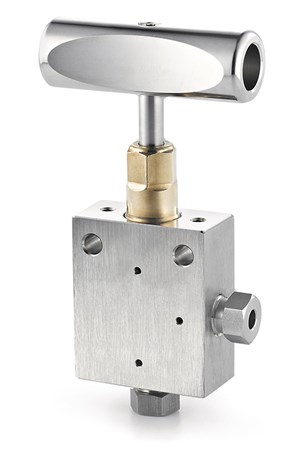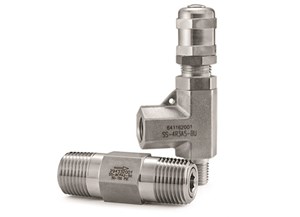Articles
Choose the correct high-performance H2 valve
Special Focus: H2 Equipment and Services
C. HAYES, Swagelok Company, Cleveland, Ohio
As the world moves away from fossil fuel mobility solutions, hydrogen (H2) has become an attractive alternative. Real-world experience proves that it is safe, cost-effective, practical and sustainable. However, the transition to H2 fuels has its challenges.
An entirely new fuel infrastructure must be designed and built with the highest-quality materials to ensure leak-tight performance. Additionally, such infrastructure must be designed to last for years or even decades, which is why choosing components with the proper construction is so vital. Unlike other fueling solutions, H2 handling and production equipment requires components with specific performance criteria.
Critical to these systems are the valves that control H2 flow. Regardless of what type of valve is chosen for each specific application (e.g., ball valve, needle valve, check valve), selecting valves that deliver exceptional performance is crucial to ensure H2 fuel systems work properly. This article explores critical considerations for keeping H2 systems leak-free.
Why high-performance matters in H2 valves. Specifying H2 valves is complex because a H2 fuel system’s operating conditions are more challenging than traditional fuel systems. In choosing the right H2 valves, manufacturers should consider the following:
- Pressure. H2 must be stored in on-vehicle tanks at 350 bar–700 bar to achieve the desired density.
- Stress and vibration. Systems must withstand fast speeds, bumpy roads and inclement weather conditions.
- Safety. Refueling stations must be safely operable by the average consumer.
- Maintenance. Ease of maintenance is critical to making joints leak-tight while they are being serviced.
Each specified H2 valve should perform well enough to meet these standards and be leak-tight at the connection and shutoff/regulation points. Importantly, valves should withstand harsh conditions within H2 fueling systems without breaking down.
What makes H2 different? Containing H2 molecules is always challenging because they are some of the smallest molecules in the natural world, and each connection point must be leak-free. If H2 leaks, it can pose a safety risk to end users when fueling their vehicles. It is analogous to gasoline leaking out of a vehicle or storage tank.
Lower-quality stainless-steel components are most susceptible to H2 molecules diffusing into them, a situation known as H2 embrittlement. H2 embrittlement can cause fissures or cracks in components, leading to potentially hazardous H2 leaks. High-quality 316/316L stainless steel helps prevent and resist the effects of H2 embrittlement.
When designing H2 infrastructure, the type of stainless steel used is vital to avoid installing easily embrittled components. Properly constructed components have a higher concentration of chromium and nickel, which enables greater ductility and corrosion resistance. According to the American Society for Testing and Materials (ASTM), stainless steels with a 12% minimum nickel level, as opposed to the traditional standard of 10% for most applications, are better for H2 applications. Finding a supplier that uses stainless steel with 12% nickel is essential when building a H2 fueling system, particularly regarding the system’s valves.
Ball valves. Ball valves are frequently used in systems to start and stop the flow of H2 in different directions. When specified for H2 applications, they should have stem seal designs that will not significantly degrade over the component’s lifecycle, and it may make sense to use a trunnion-style ball with a direct-load design to ensure leak-tight performance. If specifying a ball valve in a H2 application, the stem seal should be constructed from highly resistant materials to wear to protect the end user (FIG. 1). In addition, using a bottom-loaded stem design can lower the chances of a stem blowout, which keeps end users safer.
If there is any question about which ball valve to use, suppliers should offer their expertise in selecting the right one for specific applications. They may recommend ball valves with two- or three-way functionality, different mounting options and a range of flow coefficients that can be tailored to particular situations. Finally, choosing fitting ends on the valves designed specifically for H2 applications is important to ensure they work as needed.
Needle valves. For applications where fine adjustments to fluid flows are necessary, it is recommended to use needle valves with a metering stem. For H2 fuel systems, additional considerations apply when choosing which valves will work best. Typically, needle valves are completely made of metal, and require a large amount of force to seal correctly. H2 needle valves are subject to significant forces to open and close and must be built to withstand the strains associated with this additional force (FIG. 2). This substantial force can deform the needle and possibly displace the seat, which could cause hazardous leaks and require expensive maintenance. Secondarily, the force usually requires large air actuators to open and close the valves.
This is why it is critical to choose needle valves constructed from high-quality 316 steel because they are less likely to deform over time. Furthermore, not all needle valves have the proper pressure ratings for H2 applications (ranging from 350 bar–700 bar). When selecting needle valves for these purposes, choosing valves that can work in high-pressure situations is vital. Similar to ball valves, manufacturers should select needle valves compatible with other H2-qualified components.
Check valves. Finally, check valves keep refueling systems safe from excess backflow. Unlike typical check valves in other situations, H2 check valves must meet specific requirements to be useful. Check valves perform essential safety functions in H2 compressors in refueling systems, reducing excess backflow to keep consumers safe (FIG. 3).
For example, most check valves contain springs, which are more susceptible to H2 embrittlement because the springs are not typically made with 316 stainless steel. Check valves in H2 applications must also withstand significant changes in temperature and pressure, which put more strain on their elastomer seals. As with all valves, check valves must be compatible with other H2 components.
Securing the right components. For H2-powered mobility to become the norm, the safety, reliability and durability of its vehicles and infrastructure are key. Finding a supplier that can offer ball, needle and check valves that are properly constructed for H2 systems is paramount for any manufacturer of H2 equipment. After all, choosing the right components for the H2 systems in question is crucial to ensure the technology can expand its utility in the mobility space.H2T
About the author

CHUCK HAYES is Principal Engineer for Swagelok Company.




